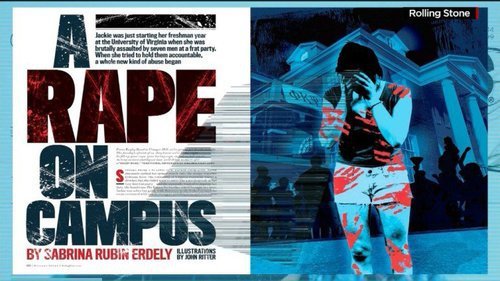
How Skepticism Spread About the Rolling Stone Rape Story
By Steve Sailer
12/05/2014
On November 19th, Rolling Stone posted “A Rape on Campus: A Brutal Assault and Search for Justice at UVA” to immense acclaim.
On November 24th, veteran editor Richard Bradley asked on his personal blog Shots in the Dark “Is the Rolling Stone Story True?”
Below are the only comments made on Bradley’s post before I linked to his post on November 29th, after which the floodgates opened.
351 Responses
- Steve Sailer 11/25/2014 6:51 am
Perhaps this media furor about UVA has something to do with the murder of UVA coed Hanna Graham in September? With all the recent news stories of bad behavior against women by black men, such as Bill Cosby, Ray Rice, and the suspect in the Graham murder, there’s a real hunger right now for a tale of evil white men. That doesn’t mean this Rolling Stone story isn’t completely true; but, like you say, it sure complies with current prejudices far better than most of the recent stories of women being abused by men.
- Steve Sailer 11/25/2014 7:57 am
So this is a pre-planned, traditional annual fraternity initiation gang-rape, with two older fraternity brothers coaching the seven pledges but not partaking themselves? Yet, it doesn’t seem very well organized at all, such as leaving a glass table in the middle of the room to immediately fall over and smash. And the pitch darkness — or at least it’s dark enough so nobody can see where the glass table is, but not so dark that the poor victim can’t recognize her assailant from anthropology class — seems odd, too. Don’t these animalistic rapists want to watch? Presumably, the pitch darkness is to prevent the victim from identifying her assailants, but she can already identify the ringleader Drew. And how many pledges are there at this fraternity anyway? Seven? Then what good does darkness do to cloud their identities? Or say there are twelve pledges. Even if the victim couldn’t identify any (besides Drew) isn’t there a lot of worry that the police would just arrest all twelve and wait for one or two of the five who weren’t rapists to get cold feet and ID the real perps in return for immunity?
- Steve Sailer 11/25/2014 11:14 am
A problem with the plausibility of the story is the source’s insistence that she was sober and remembers every detail accurately. Relax that constraint and the story would seem less unlikely because inconsistent or improbable details could be chalked up to alcohol fog.
- Steve Sailer 11/27/2014 4:20 am
Sorry to keep coming back to this, but I’ve done some more thinking and here’s where the story falls apart: pitch darkness _and_ broken glass on the floor. The glass table is smashed, but nobody turns on the light to see what happened or where the broken glass is? Instead, each man, having heard the glass table get smashed, still gets down on the floor covered with shards of broken glass, risking not only his hands and knees, but also pulling out an even more personal part of his anatomy, one that he only has one of. Really?
Then, my readers followed up with numerous insightful comments on Bradley’s blog on November 29th and 30th. On December 1st, articles started appearing citing Bradley’s post in places like Reason, the WSJ, and Jonah Goldberg’s column in the L.A. Times.
From December 2nd, onward, the Washington Post took the lead, actually doing new shoe leather reporting. The New York Times, however, published only one wishy-washy story about doubts, then on December 4th published a long article on the supposed rape culture crisis on campus and in the military, credulously citing the Rolling Stone story repeatedly.
Today, Rolling Stone has apologized for the article and the Washington Post has much new reporting about it.
So score one for the WaPo over the NYT.
And here’s my Taki’s Magazine article from earlier this week “A Rape Hoax for Book Lovers.”

Wouldn’t the rapists get cut by the broken glass all over the floor, too? I guess they were such sex-crazed animals that they didn’t notice the glass cutting their hands and knees for the first three hours.